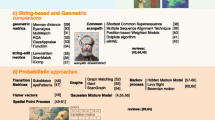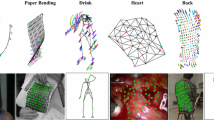Abstract
In some computer vision applications, we may need to analyze large numbers of similar frames depicting various aspects of an event. In this situation, the appearance may change significantly within the sequence, hampering efforts to track particular features. Active shape models [1] offer one approach to this problem, by ”learning” the relationship between appearance and world-state from a small set of hand-labeled training examples. In this paper we propose a method for partitioning the input image set which addresses two problems: first, it provides an automatic method for selecting a set of training images for hand-labeling; second, it results in a partitioning of the image space into regions suitable for local model adaptation. Repeated application of the partitioning procedure results in a tree-structured representation of the image space. The resulting structure can be used to define corresponding neighborhoods in the shape model parameter space; a new image may be processed efficiently by first inserting it into the tree, and then solving for model parameters within the corresponding restricted domain. The ideas are illustrated with examples from an outdoor gaze-tracking application.
Preview
Unable to display preview. Download preview PDF.
Similar content being viewed by others
References
Cootes, T.F., Taylor, C.J.: Statistical models of appearance for medical image analysis and computer vision. In: Proc. SPIE Med. Imag., vol. 1, pp. 236–248 (2001)
Gersho, A., Gray, R.M.: Vector Quantization and Signal Compression. Kluwer Academic Publishers, Dordrecht (1992)
Carpenter, R.H.S.: Movements of the Eyes. Pion (1977)
Kowler, E.: Eye Movements and Their Role in Visual and Cognitive Processes. Elsevier, Amsterdam (1990)
Cover, T.M., Hart, P.E.: Nearest neighbor pattern classification. IEEE Transactions on Information Theory IT-13, 21–27 (1967)
Duda, R.O., Hart, P.E., Stork, D.G.: Pattern Classification. John Wiley and Sons, Chichester (2001)
Tenenbaum, J.B., de Silva, V., Langford, J.C.: A global geometric framework for nonlinear dimensionality reduction. Science 290, 2319–2323 (2000)
Christoudias, C.M., Darrell, T.: On modelling nonlinear shape-and-texture appearance manifolds. In: Schmid, C., Soatto, S., Tomasi, C. (eds.) Proc. IEEE Computer Society Conference on Computer Vision and Pattern Recognition (CVPR), pp. 1067–1074 (2005)
Ohno, T., Mukawa, N., Yoshikawa, A.: Freegaze: a gaze tracking system for everyday gaze interaction. In: Duchowski, A.T., Vertegaal, R., Senders, J.W. (eds.) Proc. Eye Tracking Research & Applications Symposium (ETRA), pp. 125–132. ACM, New York (2002)
Author information
Authors and Affiliations
Editor information
Editors and Affiliations
Rights and permissions
Copyright information
© 2005 Springer-Verlag Berlin Heidelberg
About this paper
Cite this paper
Mulligan, J.B. (2005). A Tree-Structured Model of Visual Appearance Applied to Gaze Tracking. In: Bebis, G., Boyle, R., Koracin, D., Parvin, B. (eds) Advances in Visual Computing. ISVC 2005. Lecture Notes in Computer Science, vol 3804. Springer, Berlin, Heidelberg. https://doi.org/10.1007/11595755_37
Download citation
DOI: https://doi.org/10.1007/11595755_37
Publisher Name: Springer, Berlin, Heidelberg
Print ISBN: 978-3-540-30750-1
Online ISBN: 978-3-540-32284-9
eBook Packages: Computer ScienceComputer Science (R0)




